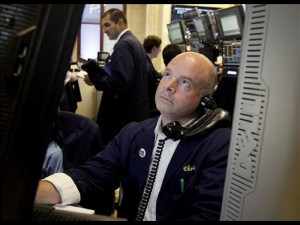
In this July 3, 2012, file photo, a trader studies his screen as he works on the floor of the New York Stock Exchange. US stock futures fluctuated in volatile trading Thursday, July 5, 2012, as banks in China and Europe took action to bolster flagging economies and poor retail sales for June offset some promising job numbers from the Labor Department. AP PHOTO/RICHARD DREW
NEW YORK—US stocks ended lower Thursday, shrugging off moves by central banks in China and Europe to boost growth and honing in on US data showing weakness in consumer spending.
The Dow Jones Industrial Average ended down 47.15 points (0.36 percent) to 12,896.67.
The S&P 500-stock index lost 6.44 (0.47 percent) to 1,367.58, while the tech-rich Nasdaq added a bar 0.04 points (0.00 percent) to 2,976.12.
Stocks had risen on Tuesday – markets were closed Wednesday – in anticipation that the European Central Bank would cut interest rates and the Bank of England would boost stimulus efforts.
The Bank of China joined in Thursday with its own surprise rate cut.
“These actions are all related to disappointing economic conditions that might otherwise be producing downward pressure on prices,” said Dick Green of Briefing.com.
But US markets showed more concern about the ICSC June sales report showing same-store sales for big retailers excluding Walmart were only up 0.2 percent from a year ago – a third straight month of weak growth.
“The second quarter is proving to be a real downer for retailers and consumers alike,” said Chris Christopher at IHS Global Insight.
Costco lost 0.4 percent, Target was down 1.1 percent and Rite Aid 3.5 percent on disappointing sales.
Energy shares also pulled lower. ExxonMobil lost 0.8 percent, Chevron 1.3 percent, and ConocoPhillips 2.0 percent.
The Libor rate-fixing scandal cast a shadow over banks involved fixing the US dollar Libor.
JPMorgan Chase fell 4.2 percent, Citigroup, 2.9 percent, and Bank of America lost 3.0 percent.
Google was up 1.4 percent and Apple 1.8 percent after The Wall Street Journal reported that Apple is preparing to launch a smaller tablet computer in a bid to maintain its edge in the hot market.
Netflix soared 13.4 percent after the company said streaming service had grown faster than forecasts.
Bond prices edged higher. The yield on the 10-year Treasury fell to 1.60 percent from 1.63 percent Tuesday, while the 30-year yield moved to 2.72 percent from 2.74 percent.
Bond prices and yields move in opposite directions.